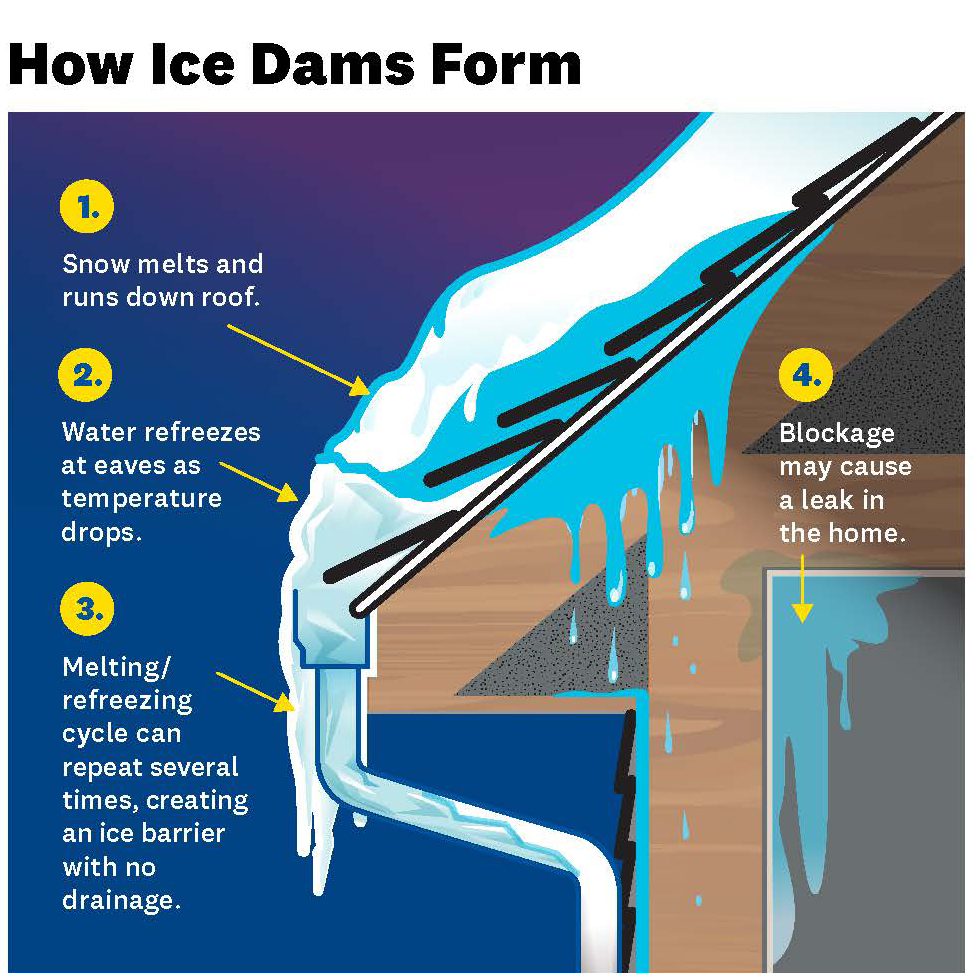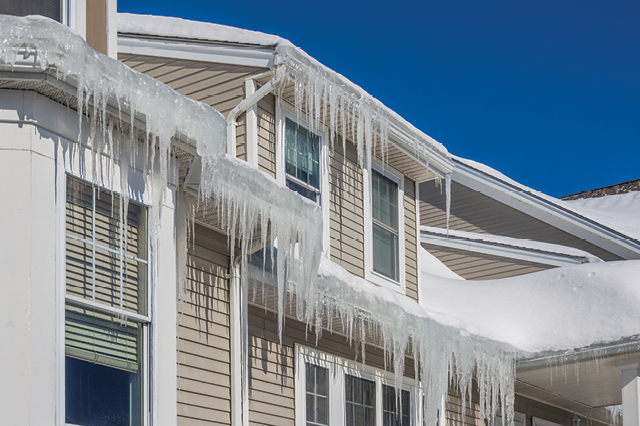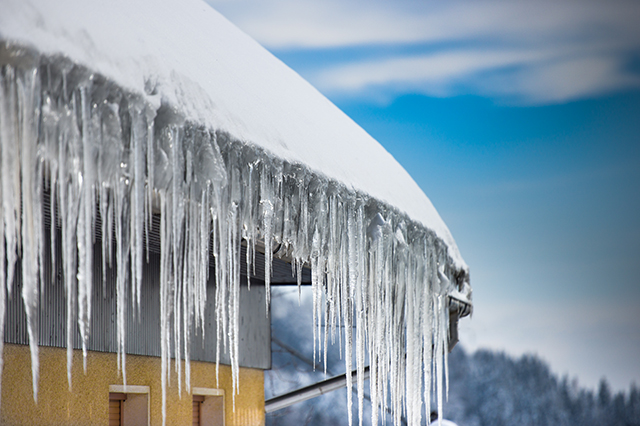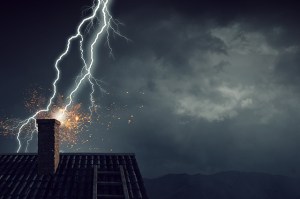While seeing your home decorated with long, sparkling icicles hanging down from the roof might look pretty enough to paint, ice dams can cause damage to the interior and exterior of your house. The key to ice dam prevention is staying on top of regular home maintenance before and during the winter.
What Are Ice Dams?
Created by melting snow running down from the roof and refreezing as the temperature drops, ice dams form at the cold eaves of the house and jut down like frozen stalactites. This barrier of ice prevents melting snow from getting the proper drainage that it needs, causing water to back up and possibly leak through the shingles, down into the home.

What Causes Ice Dams?
Ice dams need three things to form:
- Snow.
- Heat from a building.
- Cold air to refreeze the melted snow into solid ice.
“In New England, ice dams tend to form in more northern exposed parts of the roof because of the limited sun that they get,” said Jodi DeSantis, vice president of insurance sales for AAA Northeast.
As water continues to melt and refreeze, it can cause the dam to get bigger and bigger. “What happens over time is that the forming ice tends to clog any gutters, and subsequent melting and freezing cycles will start to form these huge icicles hanging off of the roof’s edges,” DeSantis said.
Ice Dam Damage
National data collected between 2018 and 2022 lists water damage and freezing among the most common homeowners insurance claims, according to the most recent report from the Insurance Information Institute.
For some homeowners, the weight of ice dams can rip off gutters or lead to broken shingles. But it’s the resulting water damage that can be the most devastating. Water damage caused by ice dams can be extensive and expensive, affecting ceilings, walls and insulation, and can eventually lead to issues with mold.
Water stains on the ceiling or walls are usually the first sign of damage caused by ice damming.
Ice Dam Prevention
To avoid the potential risks, knowing how to prevent ice dams is imperative. If you start to notice an issue with ice dams forming on your home, there are some precautions you can take.
Add Insulation
Adequate attic insulation is one way to winterize your home, which keeps the heat inside your house from escaping into your attic and prevents snow from melting too fast. Proper attic venting also helps to maintain a cooler temperature on your roof.
Clean the Gutters
To lessen the chance of ice building up around gutters, you should try to clean out leaves and debris before the first snow.

How to Get Rid of Ice Dams
To decrease the chance of ice damming, “the only thing you can do is to get rid of the ice as quickly and as safely as possible,” DeSantis said.
Immediately after a storm, use a roof rake to clear as much snow off as you can, even if it’s just around the gutter line. Do not climb onto the roof to do this. If you need a more thorough cleaning, consider hiring a contractor to do the job for you.
Longer-term solutions include replacing your roof and gutters, especially if they appear worn out. A qualified roofer should inspect your roof every three years for leaks, cracks and other faults, according to the National Association of Home Builders.
How You Are Covered
Standard homeowners insurance will generally cover water damage or any roof damage that occurs as a result of ice dams, though you may need to pay a deductible. If you own a condominium, Unit Owners Building Property Endorsement Special Coverage (often called Unit Owners Special Coverage A) broadens condo coverage to what are referred to as “open perils,” and allows for the coverage of ice dams. Without this coverage, many insurance companies will not cover ice dam damage on a condo.
Once ice damming damage has occurred, there is a typical requirement that obligates the homeowner to take the necessary action to limit any further damage such as moving furniture or artwork from the path of the water coming into the house.
Ice dams can be destructive, but extensive damage can be thwarted with preventive home improvements and maintenance. Preparing your house for wild winter weather will save you money and stress in the long run.
Have you ever experienced any trouble from ice damming? Tell us about it in the comments.
Learn more about AAA homeowners insurance, get a quote or speak with an agent today.
This article has been updated and republished from a previous version.
8 Thoughts on “Ice Dam Prevention and Removal”
Leave A Comment
Comments are subject to moderation and may or may not be published at the editor’s discretion. Only comments that are relevant to the article and add value to the Your AAA community will be considered. Comments may be edited for clarity and length.













Only one thing works: insulation.
On a previous home, I bought LeafGuard-brand gutters with a seamless built-in cover to keep out leaves. One year I had icicles down to the ground. But it did keep the leaves out.
I installed de icing cables which prevent built up ice in gutters. Works for me and cost around $100.
I have the same problem and will be replacing my leaf guards when the weather warms up. The new leaf guards will not be placed on the bottom edge of the roof. Instead, they will attach only to the gutter, like the Leaf Filter.
We paid $4032 for gutters called Leaf Guard so my husband didn’t have to climb ladders and clean gutters. BUT when it snows and freezes the water that melts from roof freezes and creates water to freeze. I now have gutters full of ice and ice forming over the edges. Not happy!
We have the same problem my husband believes that is what is causing the ice dams
Really enjoy these articles very informing keep up the good work,thanks
I rake after every snow. I had one dam and water dripped in down a window. Luckily it was over the kitchen sink. Now I have an extra 30″ of covering on the roof to prevent the leakage. I still rake as the back can get really really thick with ice. Just have to rake about 2′ back.